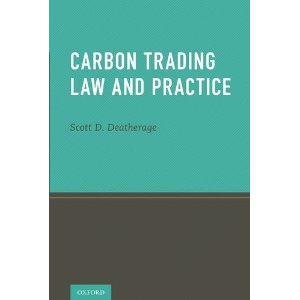Carbon trading has become a multibillion dollar business that appears to be on a future growth trend despite the uncertainties in the United States at the national level and about the international treaty under the aegis of the United Nations. ~ Scott Deatherage
 [1]In “Carbon Trading Law and Practice [2],” author Scott Deatherage provides practitioners with a comprehensive practical guide to the US and international practice of carbon emissions trading. The book includes a comprehensive examination of state, federal, and international climate change and greenhouse gas laws and regulations, emissions trading, international and EU law, other reduction programs, carbon credit projects and financing, climate change disclosure, and the US regulatory regime for greenhouse gas regulation and emissions trading. The book also provides a detailed description of the development and current status of greenhouse gas regulations in the United States, and the current state of affairs in terms of US carbon markets.
[1]In “Carbon Trading Law and Practice [2],” author Scott Deatherage provides practitioners with a comprehensive practical guide to the US and international practice of carbon emissions trading. The book includes a comprehensive examination of state, federal, and international climate change and greenhouse gas laws and regulations, emissions trading, international and EU law, other reduction programs, carbon credit projects and financing, climate change disclosure, and the US regulatory regime for greenhouse gas regulation and emissions trading. The book also provides a detailed description of the development and current status of greenhouse gas regulations in the United States, and the current state of affairs in terms of US carbon markets.
The Kyoto Protocol [3] is by the United Nations Framework Convention on Climate Change (UNFCCC or FCCC), aimed at fighting global warming. The UNFCCC is an international environmental treaty with the goal of achieving the “stabilization of greenhouse gas concentrations in the atmosphere at a level that would prevent dangerous anthropogenic interference with the climate system.” Under the Protocol, 37 countries commit themselves to a reduction of four greenhouse gases (GHG) (carbon dioxide, methane, nitrous oxide, sulphur hexafluoride) and two groups of gases (hydrofluorocarbons and perfluorocarbons) produced by them, and all member countries give general commitments
Under the UNFCCC, countries are permitted to use a trading system to help meet their emissions targets. In principle, a country may allocate permits to individual companies for the emission of a certain quantity of greenhouse gases. Carbon emissions trading is a form of emissions trading that specifically targets carbon dioxide (calculated in tonnes of carbon dioxide equivalent or tCO2e) and it currently constitutes the bulk of emissions trading. This form of permit trading is a common method countries utilize in order to meet their obligations specified by the Kyoto Protocol; namely the reduction of carbon emissions in an attempt to reduce (mitigate) future climate change.
The value of the global market in carbon emissions permits edged up 1 percent in 2010 to $120.9 billion. The value rose due to higher carbon prices, notwithstanding a 12 percent drop in the total traded volume at 7 billion metric tons of carbon emissions allowances and offsets. The greatest decline was in the United States, where trade in a regional scheme in north-eastern states fell 76 percent, after the U.S. cap and trade was put on ice. The Obama administration is now considering a carbon-trading system under existing law if Congress doesn’t pass cap-and-trade legislation that allows companies to buy and sell the right to pollute.
The pros and cons of carbon credits continue to be debated by the international community. One criticism of carbon trading is that it is a form of colonialism, where rich countries maintain their levels of consumption while getting credit for carbon savings in inefficient industrial projects. Another criticism is this does not reduce emissions. Rather, it simply is a redistribution of emissions allowances.
However, more and more companies are participating in environmental credit markets, including regulated and voluntary markets for carbon and other greenhouse gas emission reductions and renewable energy credits.
Motivations for participating in these markets include:
- Complying with international, national, state, or local mandates – or hedging against the risk of future mandates.
- Demonstrating corporate social responsibility to customers or shareholders;
- Gaining experience in new markets.
- Taking advantage of emerging investment opportunities in new “green” or clean energy and technology markets.
- Monetizing emission reduction or sequestration activities.
The use of market-based systems as a means of regulating emissions and other environmental pollution or degradation is a growing phenomenon. As nations and states appear to be responding to scientific pronouncements regarding the existence and causes of climate change, environmental markets appear to be one of the main tools that will be used to address greenhouse gas emissions. Carbon Trading Law and Practice provides the fundamental explanation and the underlying legal systems and issues that serve to create and sustain carbon credit creation and the trading of these credits, and a series of related legal and business issues.
“Carbon Trading Law and Practice [2],” by Scott Deatherage, Oxford University Press, 346 pages is available from Amazon [2].
About the Author
Scott Deatherage has practiced environmental law for the last 20 years, and currently is a partner with the firm of Patton Boggs in Dallas, Texas. He is the head of Thompson & Knight’s Climate Change and Renewable Energy Practice Group is a member of the firm’s environmental, energy, and renewable energy groups.